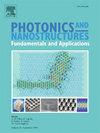Inter-mode backward stimulated Brillouin scattering in lithium niobate core fiber
IF 2.9
3区 物理与天体物理
Q3 MATERIALS SCIENCE, MULTIDISCIPLINARY
Photonics and Nanostructures-Fundamentals and Applications
Pub Date : 2025-07-06
DOI:10.1016/j.photonics.2025.101426
引用次数: 0
Abstract
Brillouin sensing in multimode optical fibre enables the simultaneous modal transmission of multiple modulus, such as temperature and strain, and helps to promote the development of simultaneous multi-property sensing techniques. Among these, intermodal backward Brillouin scattering induced by higher order modes (HOMs) is of great importance for understanding the phonon-photon interaction in multimode fibre. In addition, lithium niobate (LiNbO3) materials have potential applications in sensing due to their excellent electro-optical properties, which are expected to provide higher sensitivity and accuracy. In this paper, the inter-mode BSBS induced by higher order optical modes in micron scale LiNbO3 optical fibre is investigated. The inter-mode excited Brillouin scattering characteristics of the first 10 LP modes in the fibre are simulated and analysed by finite element simulation. During backward Brillouin scattering, several longitudinal acoustic modes (LAMs) are excited. However, only a few specific low-order LAMs are involved in the interaction between different optical mode pairs, resulting in Brillouin amplification. In this paper, we elucidate the differences in the gain characteristics of the Brillouin gain spectra between different modes and reveal the acoustic mode law that contributes most to the BGS in the inter-mode BSBS. The results show that both the effective refractive index (2.1847–2.2072) and the Brillouin scattering frequency shift (20.6–20.9 GHz) decrease with the increase of mode order in this structure. And the Brillouin gain reaches 0.4244 m−1·W−1, which is a significant improvement compared with the conventional SiO2 fiber, predicting the improvement of sensitivity in sensing.
铌酸锂芯光纤中的模间反向受激布里渊散射
多模光纤布里渊传感实现了温度、应变等多模量的同时模态传输,有助于促进多特性传感技术的发展。其中,高阶模(HOMs)诱导的多模后向布里渊散射对于理解多模光纤中声子-光子相互作用具有重要意义。此外,铌酸锂(LiNbO3)材料由于其优异的电光性能,有望提供更高的灵敏度和精度,在传感领域具有潜在的应用前景。本文研究了高阶光模在微米尺度LiNbO3光纤中诱导的模间BSBS。采用有限元方法模拟分析了光纤中前10个LP模间激发布里渊散射特性。在后向布里渊散射过程中,多个纵向声模被激发。然而,只有少数特定的低阶lam参与不同光模对之间的相互作用,导致布里渊放大。本文阐述了不同模式下布里渊增益谱增益特性的差异,揭示了在模间BSBS中对BGS贡献最大的声模规律。结果表明,该结构的有效折射率(2.1847 ~ 2.2072)和布里渊散射频移(20.6 ~ 20.9 GHz)随模阶的增加而减小。布里渊增益达到0.4244 m−1·W−1,与传统SiO2光纤相比有显著提高,预示着传感灵敏度的提高。
本文章由计算机程序翻译,如有差异,请以英文原文为准。
求助全文
约1分钟内获得全文
求助全文
来源期刊
CiteScore
5.00
自引率
3.70%
发文量
77
审稿时长
62 days
期刊介绍:
This journal establishes a dedicated channel for physicists, material scientists, chemists, engineers and computer scientists who are interested in photonics and nanostructures, and especially in research related to photonic crystals, photonic band gaps and metamaterials. The Journal sheds light on the latest developments in this growing field of science that will see the emergence of faster telecommunications and ultimately computers that use light instead of electrons to connect components.

 求助内容:
求助内容: 应助结果提醒方式:
应助结果提醒方式:


